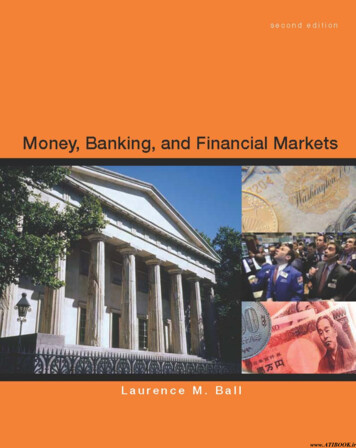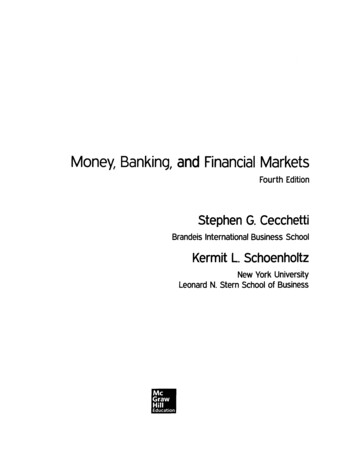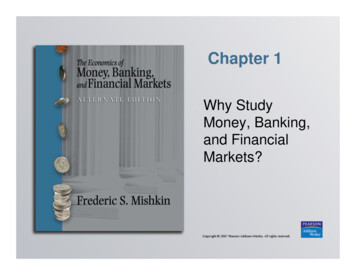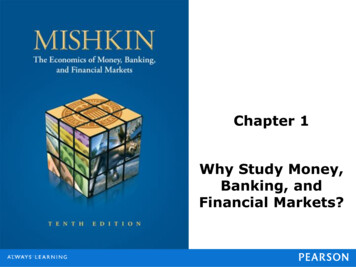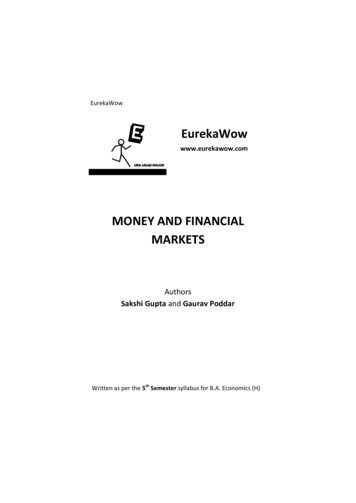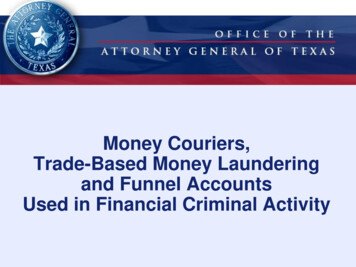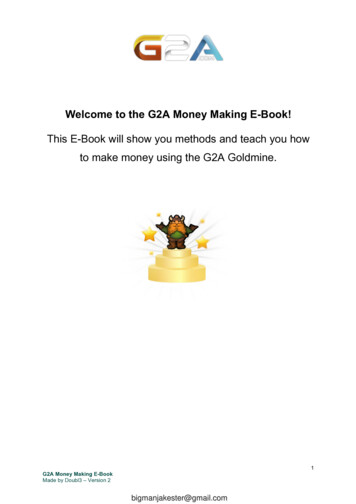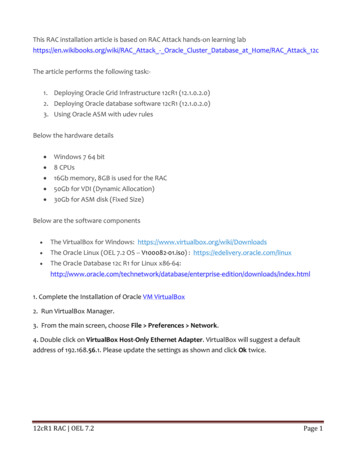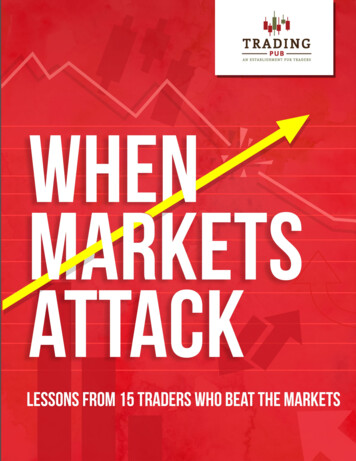
Transcription
When Markets Attack1
WHENmarketsattackLessons From 15 Traders Who Beat The Markets
Risk DisclaimerThere is a very high degree of risk involved in trading. Past results are not indicative of futurereturns. Tradingpub.com and all individuals affiliated with this site assume no responsibilitiesfor your trading and investment results. The indicators, strategies, columns, articles and allother features are for educational purposes only and should not be construed as investmentadvice. Information for futures trading observations are obtained from sources believed to bereliable, but we do not warrant its completeness or accuracy, or warrant any results from theuse of the information.Your use of the trading observations is entirely at your own risk and it is your sole responsibilityto evaluate the accuracy, completeness and usefulness of the information. You must assessthe risk of any trade with your broker and make your own independent decisions regardingany securities mentioned herein. Affiliates of tradingpub.com may have a position or effecttransactions in the securities described herein (or options thereon) and/or otherwise employtrading strategies that may be consistent or inconsistent with the provided strategies.Privacy Policy
How to Get the Most Out of This BookCam White, TradingPubThank you for downloading “When Markets Attack: Lessons from 15 Traders Who Beat theMarkets”. This book is designed for beginning, intermediate and advanced traders.The presenters in this book are leading experts in trading Stocks, Futures, Options, Forex andNadex. You will also be exposed to a chapter on Trading Psychology and how to set yourself upas a trading entity to save a lot of money on taxes.As you read this book, you will be exposed to multiple strategies that have high probabilities ofsuccess and/or high profit. These strategies were selected by pouring over webinars that havebeen hosted by TradingPub in the recent past. Each webinar was transcribed into a “game plan”for executing the strategy. Every strategy in this book is divided into three sections:The Game PlanAn introduction to the instrument being traded, whether it is Stocks, Futures, Options, Forexor Nadex. The strategy is then thoroughly explained along with illustrations and examples.The MovieOnce you have read the chapter, you can view the complete webinar on the strategy. You willgain a better understanding of the strategy along with multiple examples not covered in thechapter. In some cases, the presenter switches in to live trading to demonstrate the strategy inaction. In many of the webinars, the presenter also fields questions from attendees.Special OffersIf you really like a strategy, you can follow the presenter and the strategy. There are thousandsof dollars’ worth of trading tools, indicators, training and mentoring services, books and videosavailable at steeply discounted prices.
In short, you will have all of the information you need to trade yournew favorite strategy tomorrow.Some of the things you will learn in this book are:-How to buy Stop/Loss protection for pennies on the dollar (Nadex Spreads)-How to Retire on 13,000 per month in 5 Years Tax-Free with Credit Spreads-How to turn 156 into 1,000 trading Bond Futures, It only works 40% of thetime!-The opening of the London session can consistently put 500 in your pocket.-How to trade the markets with an account as small as 100 (Nadex)-How to stay in control your emotions when you trade.At TradingPub, it is our sincere hope that you take away several strategies that you can usewhen you are done reading this book. You will also learn about markets that you currently don’ttrade, and you will find out if they are suited to your trading personality.Finally, make sure take advantage of all the free resources from TradingPub. We host freewebinars every week for trading all of the markets. Our presenters are world-renowned industryexperts and our content is provided free of charge in a relaxed and friendly setting. Cheers toyour trading success!
TABLE OF CONTENTSI.Chapter 1- Trading Psychology“Mastering Your Inner Game” - Rande HowellII.Chapter 2- Stocks“Trading Tops and Bottoms” - Steve Primo“High Profit Candlestick Signals and Patterns” - Stephen Bigalow“2 Warning Signs to Keep you Out of Losing Trades” – Jared WesleyIII.Chapter 3- FuturesIV.Chapter 4- Options8-2224-3637-5253-6567-82“Turn 156 into 1,000 Trading 30 Year Bonds” – Hubert Senters83-94“How to Use Market Profile to Trade Futures” – Greg Weitzman95-107“30 Trading Insights to Help Overcome Your Trading Fears” – Tom Busby109-119“How to Add Weekly Options to Your Trading Arsenal” – Andrew Keene“Using Math to Generate Fantastic Short-Term Trading Profits – Chris Verhaegh 120-129“Creating the Ultimate Retirement Plan with Credit Spreads” – Peter Schultz130-142V.Chapter 5- Forex“The London Breakout Strategy” – Joshua Martinez“Predicting Markets with Volume and Price” – Nigel Hawkes“Why Your Entry Strategy [ALMOST] Doesn’t Matter” – Casey StubbsVI.Chapter 6- Nadex“Using the Power Crossover Method to Increase Probabilities” – Mark Hodge“Trading Nadex Spreads as the Ultimate Hedge Strategy” – Darrell Martin“Two High Probability Nadex Strategies” – Cam WhiteVII. Chapter 7- Trading Necessities“Trade as a Business and Save on Your Taxes” – Robert A. Green, 27
CHAPTER ITrading Psychology
When Markets AttackMastering Your Inner GameRande Howell, Med, LPCAs a trader, do you ever wonder why you can’t achieve the results that you want to achieve? Doyou find yourself constantly making the same mistakes? Are you controlled by your emotions?These are mistakes that all traders make, but the successful traders have learned how to manage their inner game. In this section, we are going to learn how to overcome the eight road blocksto successful trading.To get started, let’s first look at the components that make up a successful trade:Without integration of each component, you are an incomplete trader risk is stacked against you.8Chapter 1- Trading Psychology
When Markets AttackFirst you need to have a trading platform, trading methodology and a trading state of mind. Thereare multiple trading platforms and numerous trading methodologies you can use, so it’s importantthat you choose risk management strategy and trading platform you’re most comfortable using.But it’s also critically important to have the right trading psychology. If you don’t have the rightmindset, it really doesn’t matter about your trading platform or methodology. You need to havebalanced integration of these three critical trading components. It doesn’t matter how good you areat knowing how to trade if you can’t hold your wits together.Let’s face it, most traders early on are looking for the magical secret, or the “Holy Grail” of successfultrading. They chase the best charting software, newest indicators, data and news services,mentoring programs, you name it. What they are looking for is the magic solution to trading, whenthey don’t recognize that they themselves are the problem. There is no magical “Holy Grail” fortrading success “out there”. The secret to trading success lies within yourself, just waiting to bediscovered. Remember this adage: “80 percent of trading is in your head”.What separates the elite golfers from the rest of the field? They all have the best equipment in theindustry. They have spent countless hours practicing and perfecting their craft. They know how todrive, chip and putt. So what separates the elite golfers from the rest of the crowd? They know howto do it in the clutch, when the money is on the line. This lesson is about learning how to developthe mindset of a peak performance trader – to separate yourself from the sea of traders who areinconsistent and bleed out their accounts.Chapter 1- Trading Psychology9
When Markets AttackWhat the Untrained Brain Sees when the UntrainedMind Experiences UncertaintySince the beginning of time, our brains have been trained to see uncertainty and fear as one in thesame thing. How many times have you had your finger on the trigger, but you just couldn’t bringyourself to execute the trade? How many times have you bailed out early on a trade, only to watchit run in the direction you thought it would? That is your brain perceiving psychological discomfortas a biological threat. Unless you can untangle that association, and re-train your mind, you arelikely to repeat these behaviors over and over again.The markets don’t care about you. You can trade them as long as you have capital, but sooner orlater, usually after drawing down your accounts, you come to the realization that you need to workon yourself if you are going to be successful at trading.Recognizing that we have been historically been wired to associate psychological discomfort (fear)with a biological threat, let’s break down the components of emotions. An emotion is how the body/brain/mind gets triggered to any disruption of a familiar status. It’s a common buzzword in tradingto talk about simply taking the emotion out of trading. The reality is that the only time humans cando anything without emotion is if they’re dead. Emotions are biological and they take over ourpsychology. We need to accept that we are emotional creatures and that our psychology is governedby our emotions. So the key is - how do you manage your emotions? We don’t have freedom fromemotions, but we can have freedom of emotions. You can become the designer of theemotions that you respond to.10Chapter 1- Trading Psychology
When Markets AttackEmotions can be broken down into five major components:1.- ArousalThat’s the revving-up of an emotion. Think about yourself when you are in the midst of engaging in atrade. Your body starts tensing. You stop breathing, or your breathing may be “high” and “low”. Yourheart accelerates. Your eyes are fixated on the screen. That’s arousal, and it’s the first aspect of youremotions that you must learn to manage. If you can’t, then you will lose control of your emotions.2.- FeelingThis is where the biological chemistry creates a subjective experience of the emotion. If cortisol ispulsing through your body, it can produce a sense of fear. If testosterone levels become elevated, itproduces a sense of grandeur. Both of these responses can lead to costly trading mistakes. You canbe afraid to pull the trigger on a trade, exit a trade early or double-down on a risky trade.3.- MotivationOnce the chemistry is released into your system, your body will usually pointed into a “fight or flight”response. You perceive a threat, and you are either going to attack it or avoid it. If you hesitate ona trade, you are in avoidance. If you revenge-trade after a losing trade, you are in attack mode. It’simportant to have a trained mind to regulate these responses to a perceived threat. Developing a curious mind allows you to act with patience and discipline, keeping your long-term interests in mind.4.- MeaningThese are the beliefs you have developed to manage uncertainty. We need to rationalize our behaviors so they make sense to us.5.- TemperamentQuite simply, this is genetics. How is your body genetically predisposed to handling emotion?Chapter 1- Trading Psychology11
When Markets AttackSeparating Uncertainty, Worry and FearUnderstanding that we are emotional creatures, the first task in re-training your mind is toseparate uncertainty, worry and fear.UncertaintyYou can’t control the markets. The markets do what they want to do. Nothing can be predictedwith absolute certainty, only varying degrees of probability. We have been trained as we grew upnot to make mistakes. We have conditioned ourselves and our brains are biased to predict withcertainty.WorryIf you feel that you can’t control the outcome of a trade, then worry sets in. Your brain startsto project into the future and it’s seeing bad things on the horizon. So your brain becomes anegative assessment machine, and you continually traumatize yourself by worrying.FearFear is wear all thought becomes hijacked, and you panic or freeze.12Chapter 1- Trading Psychology
When Markets AttackThe mind that you bring into trading isn’t necessarily a mind that is conducive to successfultrading. Remember that the brain associates psychological discomfort with biological threat, andwe need to learn to avoid fight or flight behaviors. Ninety percent of traders lose money becausethey are making fear-based trades or impulse-based trades. On the fear side, they are afraid topull the trigger at the right time, or they get out of trades too early. The impulse-based trader getsinvolved in revenge trading, throwing good money after bad. What you’re looking for is mindfultrading where you make well-reasoned decisions with your emotions under control.So the question then becomes,“How do I organize my mind for higher function in trading?”Chapter 1- Trading Psychology13
When Markets AttackThe Impact of Emotions on Your TradingFear, until mastered, blocks the development of your potential. To develop as a trader, you needto be able to confront fear to change your pattern of reacting to an uncertain world. Your brain isa negative assessment machine that does not distinguish uncertainty from fear. It’s organized foravoidance, and trying to keep you in your comfort zone, which is the familiar. It forms self-fulfillingpatterns based on the avoidance of fear and uncertainty. These patterns are set on “cruise-control”and dominate your state of mind, forcing you to trade from avoidance and greed rather than calmimpartiality.The best way to get started in gaining control of your emotionsis to label your fears:1.Fear of uncertainty (hesitation)2.Fear of loss (pulling the trigger at the wrong time)3.Fear of missing out (impulse trades and exits)4.Fear based urgency to make up for prior losses (revenge trading)5.Fear of not being right (making a mistake)6.Fear of inadequacy (not feeli
Nadex. You will also be exposed to a chapter on Trading Psychology and how to set yourself up as a trading entity to save a lot of money on taxes. As you read this book, you will be exposed to multiple strategies that have high probabilities of success and/or high profit. These strategies were selected by pouring over webinars that have

